How to solve the Rubik’s Cube
Learn how to solve the “impossible puzzle” in eight simple steps
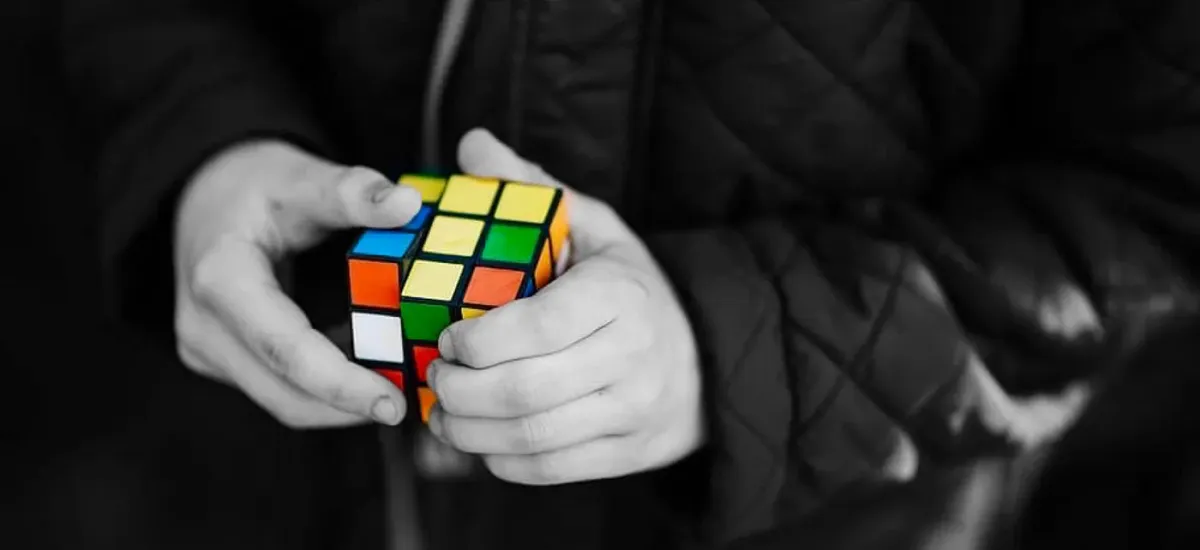
The Rubik’s Cube is a 3D permutation puzzle invented in 1974 by a Hungarian sculptor named Erno Rubik. Since its introduction to the U.S. market in 1980, the cube has become cultural icon, selling over 350 million by 2009. It is both the world’s top-selling puzzle game and the world’s best selling toy, even being featured in several movies including The Pursuit of Happiness starring Will Smith:
The cube is notoriously difficult to solve for novices. With proper instruction however, the puzzle can be solved by anyone with the right motivation and patience. This essay will teach you how in eight simple steps.
How to read Rubik's cube algorithms
To communicate which moves you should make, we make use of so-called Rubik cube algorithms. They are typically abbreviated to single letters, but in this tutorial we'll use the full words. The possible moves are:
top, bottom, left, right, front, back
In clockwise and counter-clockwise direction. When holding your cube, the side facing you is the front, and the side facing away from you is the back. The side facing your right palm is the right, the side facing your left palm is the left. The top faces up and the bottom faces down. Counter-clockwise moves are denoted by an asterisk *. For a right move, that means rotating the right layer away from you. For a left move, that means rotating the left layer towards you. For counter-clockwise moves, that means the opposite direction, and so on.
Step 1: Orient the white edges on the yellow side
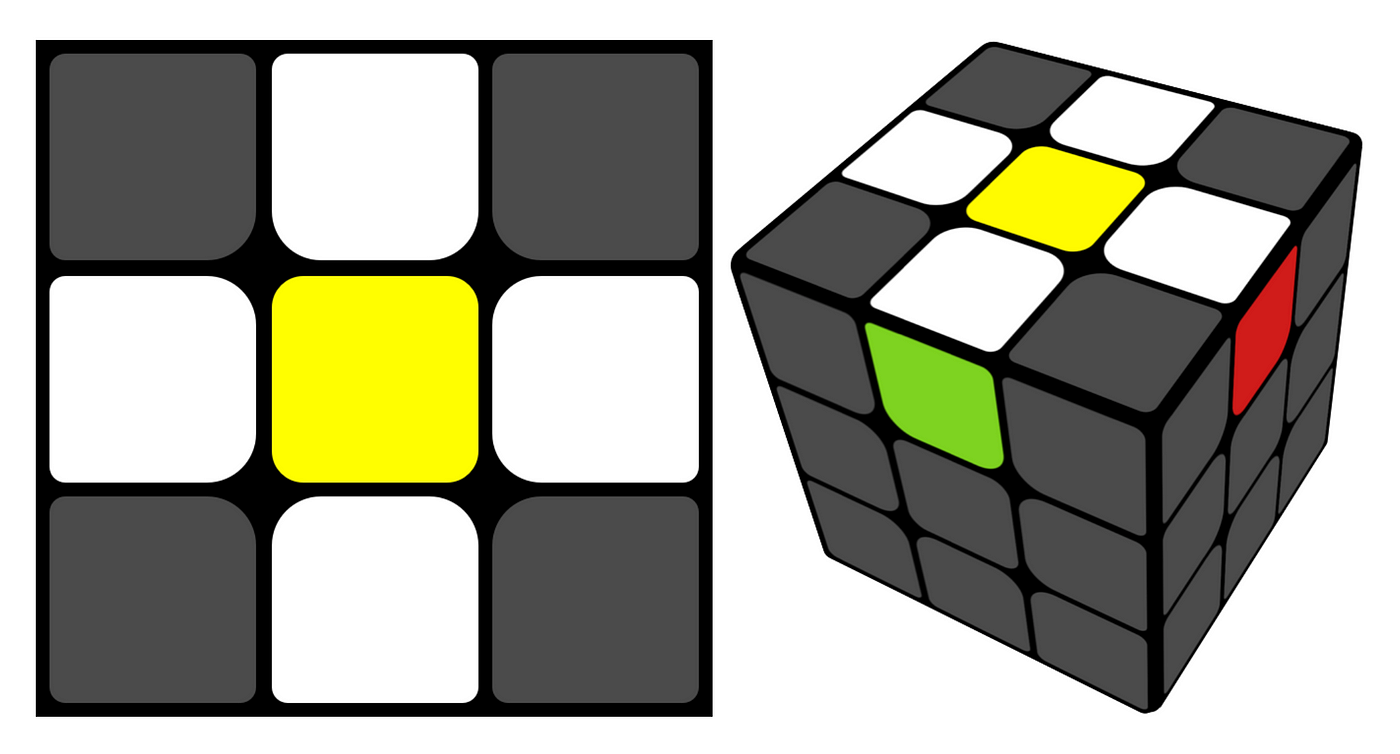
The first step is simple. All we need to do is align the four white edge pieces to the yellow side of the cube (the side with the yellow center piece). It does not matter how you get there, no algorithms are required. It also does not matter if you also get some white or yellow corners, ignore them. The only pieces we are looking at in this step are the ones highlighted on the cube above:
- The yellow center piece and
- The four white edges
Once positioned, we’ve formed a white cross with a yellow center.
Step 2: Form the white cross

The next step is also simple. What we want to do is move our white cross to the white side. In doing so, we’ll also want to make sure that the other colors on our four white edge pieces align with the correct center pieces on the rest of the cube (see right perspective image above). To do so:
- Orient the layer with the yellow side (with its white cross) so that it faces your right palm. We’ll call this layer the right layer.
- Next, rotate the two other layers (middle and left) until the center piece of the middle layer matches the top-facing edge piece of the right layer. For instance, if the right layer has a blue edge piece with a white side facing your palm, find the blue center by rotating layers left and middle.
- Once you’ve matched the center piece of the top layer with the color of the edge piece facing your palm, rotate the entire top layer so that the white edge aligns with the white center on the left layer (facing away from your right palm).
- Next, rotate your cube towards your body. A new edge piece with a white side facing your palm is now pointing up. What color is it? Find its center repeating what you did (by rotating the left and center layers until its color matches the edge piece of your right layer).
- Again, once you’ve matched the center piece of the top layer with the color of the edge piece facing your palm, rotate the entire top layer so that the white edge aligns with the white center on the left layer (facing away from your palm).
- Repeat until all four white edges have been rotated to the white side, and their associated colors align with their centers (red and green above).
Step 2 complete!
Step 3: Form the white side

Great! You’ve made it to step 3, we’re 25% of the way there. The goal of the next step is to form the “bottom” white layer, with correct edge and corner pieces on each colored side. For this step, we’ll need to pull out our first algorithm.
First, orient the cube so that your white cross is facing downwards. Next, inspect your cube. What you’re looking for is a white corner piece facing right or left (not on the yellow face), such as below:

Once you find one, orient the cube so that the corner piece has its white side facing right or left. Next, rotate the bottom two layers so that the opposite color of the corner piece is on its correct side (orange in the two examples above).
Now, if the corner piece’s white side is facing towards your right palm, execute the following algorithm:
Algorithm 1 (right)
right top right*
If the corner piece has its white side facing away from your right palm, execute the following (symmetric) algorithm:
Algorithm 1 (left)
left* top* left
What you’re doing is nudging the white corner pieces into their correct slots between the white edge pieces on the bottom side. Repeat for each white corner piece until the white side is formed, and the bottom layer is complete.
Step 4: Place edges in the middle layer
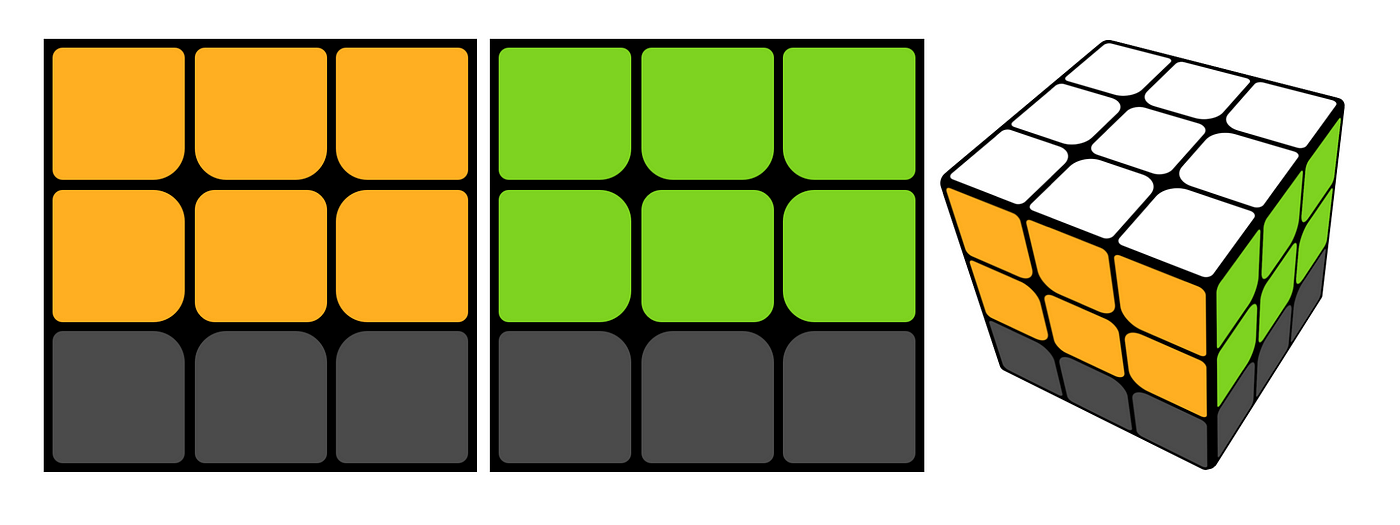
Let’s review what we’ve done so far. We’ve completed the bottom layer with the white face pointing downwards, and in the process also completed half of the middle layer: the centers. What remains, are the four edge pieces in the middle layer: orange/green, green/red, orange/blue and blue/red.
In this step, we’ll want to snap those edge pieces into their correct place in the the middle layer. To do this, in a similar way as in the previous step we’ll want to look for the edge pieces with while the yellow center piece is facing up. What we’re looking for is what I’ve illustrated below, an edge pieces of e.g. red and green (left) or green and orange (right), where one of the colors is on its correct side (red and orange below) and the second color is on the yellow side (facing up):

Once you find one, orient the cube so that the side with five squares in correct place is facing towards you (red or orange in the examples above). Now, if the other color of the edge piece needs to be moved to the right side (in the red example above: the green color towards the green side), execute the following algorithm:
Algorithm 2 (right)
top right top right* top* front* top* front
If the other color of the edge piece should be moved to the left side (in the orange example above: the green color towards the green side), execute the following (symmetric) algorithm:
Algorithm 2 (left)
top left* top* left top front top front*
A good way of remembering which algorithm to use here is to think that your first move should be moving the edge piece in the opposite direction of where you want it to end up. For the red example, that means moving the top layer clockwise. For the orange example, that means moving the top layer counter-clockwise.
What you are doing is nudging the edge pieces into their correct slots between the colored centers in the middle layer of the cube. Repeat for each colored edge piece until the middle layer is correct.
Step 5: Form the yellow cross
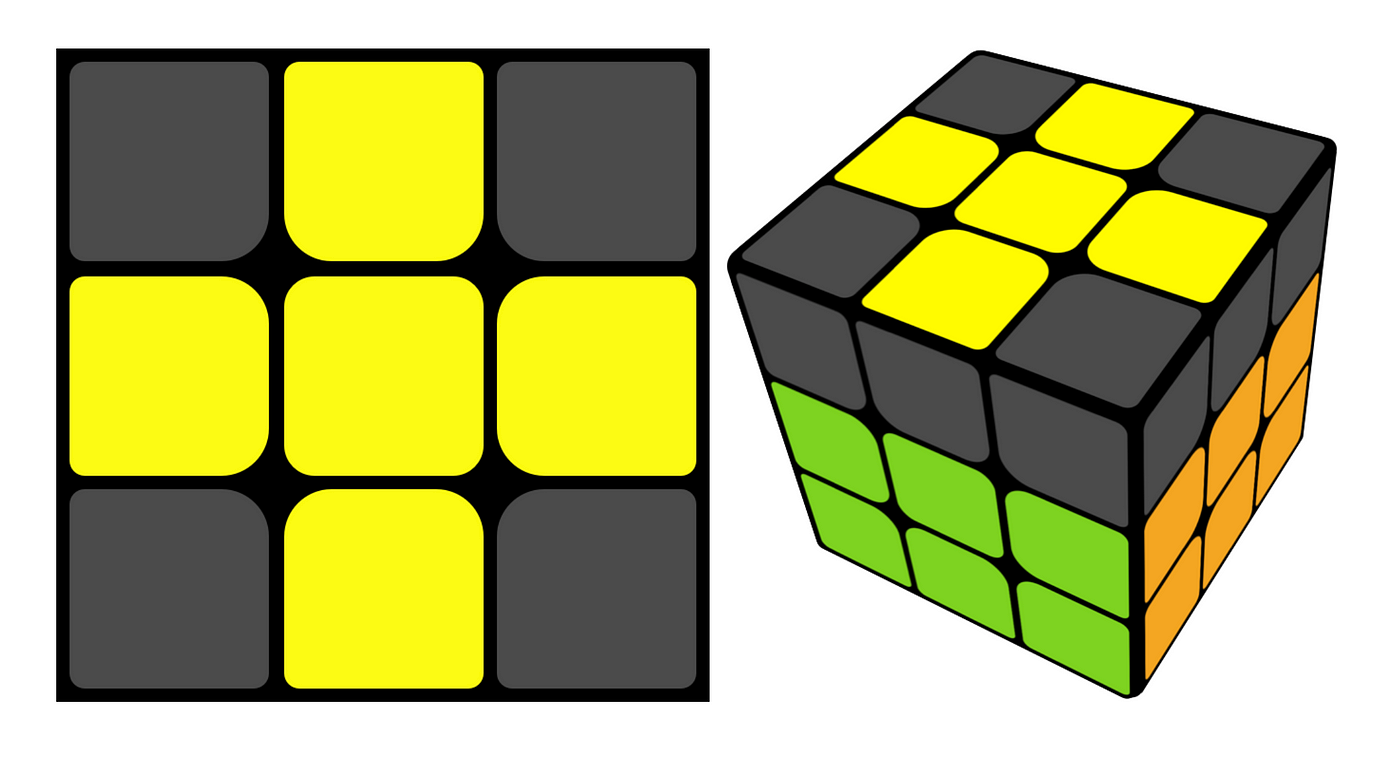
We are now making real progress. We’re over halfway there to solving the cube. Our next goal is achieving the so-called “yellow cross” on the top side, whilst not destroying the work we’ve done on the (now completed) middle and bottom layers.
For this we’ll review four basic patterns on the top (yellow) side:

There can of course be a lot of other patterns of yellow pieces, but they will all contain at least one of the four outlined above. The fourth state is the one we’re trying to get to. Orient your cube to which ever shape your top face most resembles, and execute the following algorithm:
Algorithm 3
front right top right* top* front*
If you had the yellow line, you will now have the yellow cross. If you had the top-left yellow inverse L, you will now have the yellow line and so on. Repeat until you get the yellow cross.
Step 6: Form the yellow side

We’re now ready to place the corners on the top (yellow) side. For this, we’ll use the following algorithm whilst our yellow cross is facing upwards:
Algorithm 4
right top right* top right top top right*
If we perform it correctly, the yellow face will change, whilst the two bottom layers remain intact. As for the algorithm 3, we’ll repeat algorithm 4 until we achieve the completed yellow side. Along the way, look for the the following pattern:
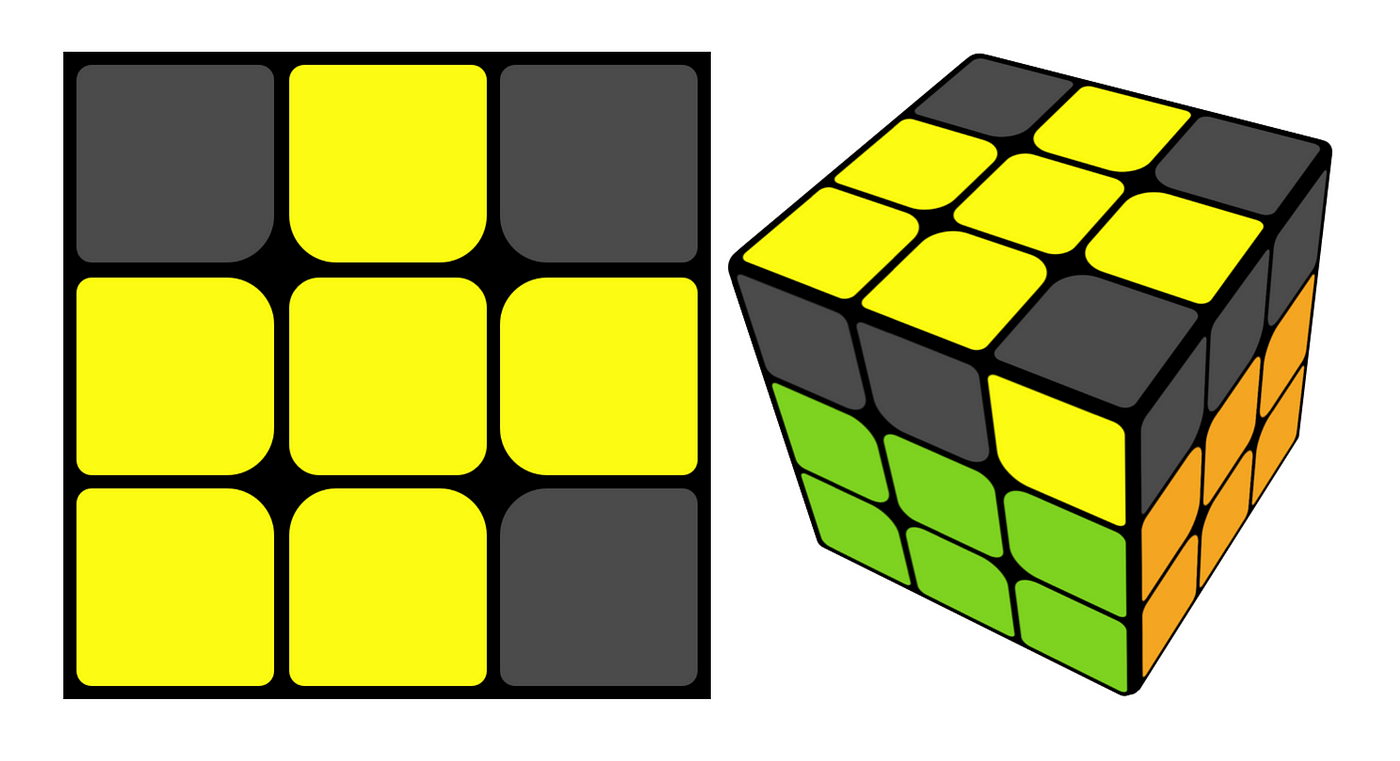
If you perform the algorithm one more time after achieving this pattern (including the yellow corner piece on the side facing you), you’ve formed the full yellow side.
Step 7: Complete one side

We’re a step away. If you’ve made it this far, you have a cube with both the bottom and middle layers as well as the top (yellow) face completed. The only remaining thing is to jumble the top layer so that the top row of the four sides are done. The first step in this process is to form one completed side. To do so, with the yellow side facing up, perform the following algorithm:
right* front right* back* back* right front* right* back back right* right*
This will form one completed side, and three sides with edges displaced. If it doesn’t, repeat. When you achieve one almost completed side (such as the orange side with red in the example above), face that away from you and perform the algorithm again, and you’ll have formed a completed side.
In rare cases, the cube will have four almost completed sides, with four edges displaced. If yours does, move on to the next step.
Step 8: Solve the Rubik’s cube

The final step is to correctly place the three displaced edge pieces on the yellow side. To do so, orient the cube so that the one completed side (blue in the example from step 7) is facing your right palm. Now, perform the following algorithm:
left left top* back front* left left back* front top* left left
Your cube is solved.





